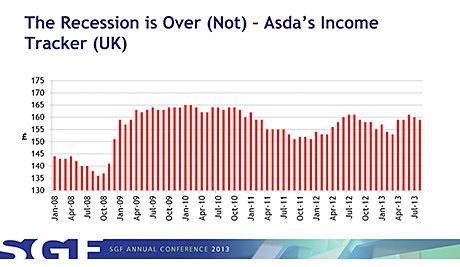We check out two more of the presentations at this year’s SGF Conference – by Professor Leigh Sparks and Dr Colette Backwell

ECONOMICALLY things will get worse before they get better, the big boys are moving into c-store territory and the pace of change isn’t going to falter.
Professor Leigh Sparks of the Department of Retail Studies at Stirling University told delegates at the Scottish Grocers’ Federation Conference that he’d been ask to talk about the future of retailing but that it had also been suggested, over lunch, that sometimes he overdid the Welsh doom and gloom. He promised he’d try to be positive. But he stressed there were unavoidable pressures that included recessionary influences and, more importantly, long-term structural changes that would alter just about everything to do with retail space and place. To sum it up: “There are too many shops!”.
However, on a more positive note he said it was often forgotten how significant retailing is to Scottish life.
Because it’s everywhere it’s taken for granted, he said.
“There are around 5,500 convenience stores in Scotland and about 40,000 or so jobs … a large and important part of the Scottish economy.”
And, as others at the SGF Conference had pointed out, it is subject to a series of pressures including political pressures on healthy eating and “all the other things that are coming down the line”.
“Government is going to continue to be interested in retail and in the convenience sector,” he said.
But there are other developments that are having important effects.

There is significant demographic change and Scotland has an ageing population. There are major changes to lifestyle and to the way we live our lives socially and culturally. Those will continue and will force retail to react.
And there are pressures on consumer behaviour and spending – some short-term and some, perhaps the more important, long-term, he said.
He showed a slide that presented the findings of the Asda income tracker, a measure that was close to but not identical to ‘disposable income’, the cash consumers have left over after taking care of necessities.
It showed, he said, that in the early days of the recession people had, in fact, been better off as government stepped in with financial policies that had kept mortgage rates low.
But for the last four years or so available cash had been flatlining and the bad news is that all available indicators suggest it will get worse before it gets better and the tough effects of the recession and its aftermath will last until the end of the decade.
But that, he suggested, isn’t the whole story. The recessionary effects are in fact a temporary pressure, an extra layer on a system of structural changes that are going to be much more important to retail, including convenience retail.
The technological changes arising from the development of the web and especially of smart phones has had a huge effect in a short time. Consumers are making extensive use of new services and sources of information.
“It’s changing how we shop and how we think about shopping,” he said.
But there are new technologies and methods being developed or at least tested by retailers in response.
While there had been clearly destructive effects from online retailing, especially on record shops and bookshops, there are now examples of a trend to what he prefers to call ‘blended’ rather than ‘multi-channel’ retailing.
In Aberdeen, House of Fraser is experimenting with a system where shoppers can choose items of clothing from a browser and then have a cup of coffee while the pieces are delivered to a changing room, he said.
In Korea there is a system at a rail station where shoppers ordered grocery goods on a touchscreen as they waited for their train and had a bag of items delivered to the platform.
And Tesco is experimenting with preparing previously ordered lists of daily essentials to be picked up by returning holidaymakers at airports.
What is clear, he said, is that there is also a revolution going on in styles and sizes of store.
The large multiples are saying the era of the giant out-of-town store is over and much of their spend will be in convenience. That means they are coming into traditional convenience retailers’ space, he said, and that can already be seen on forecourts, in transport hubs and on high streets.
But the issue is not just about convenience stores but the definition of convenience itself.
We may see more dark stores where goods are delivered and stocked but then picked only by staff members for subsequent home delivery to store customers or to pick-up points in strategic locations, he suggested.
But either way it would be new competition and traditional c-store retailers would have to find ways to compete.
The theme of the SGF was retail excellence and that would be vital, he said.
Some speakers had already spoken of the differences between a store that was owned rather than managed and was an established part of a community.
C-store retailers would have to react to changes just as much as other businesses but they may have to address other issues too, he suggested.
“One of the questions,” he said “will be ‘What does my store actually stand for?’.”


















